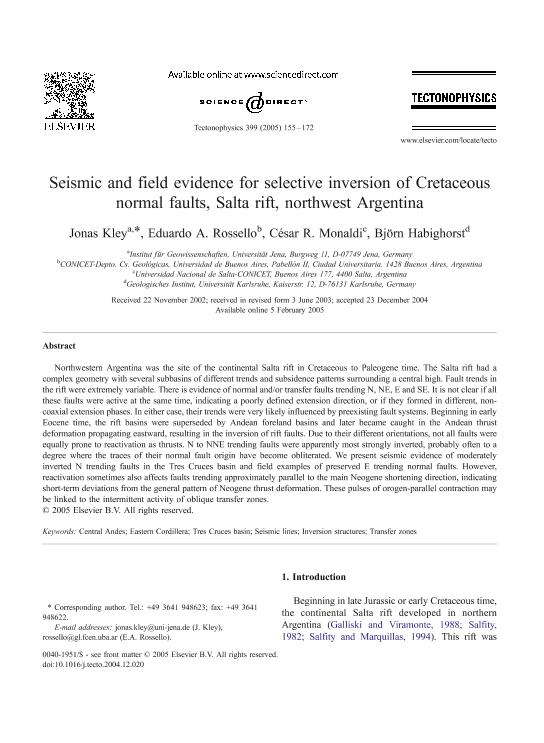Mostrar el registro sencillo del ítem
dc.contributor.author
Kley, Jonas
dc.contributor.author
Rossello, Eduardo Antonio

dc.contributor.author
Monaldi, Cesar Ruben

dc.contributor.author
Habighorst, Bjórn
dc.date.available
2019-09-10T18:33:53Z
dc.date.issued
2005-04
dc.identifier.citation
Kley, Jonas; Rossello, Eduardo Antonio; Monaldi, Cesar Ruben; Habighorst, Bjórn; Seismic and field evidence for selective inversion of Cretaceous normal faults, Salta rift, northwest Argentina; Elsevier Science; Tectonophysics; 399; 1-4 SPEC. ISS.; 4-2005; 155-172
dc.identifier.issn
0040-1951
dc.identifier.uri
http://hdl.handle.net/11336/83271
dc.description.abstract
Northwestern Argentina was the site of the continental Salta rift in Cretaceous to Paleogene time. The Salta rift had a complex geometry with several subbasins of different trends and subsidence patterns surrounding a central high. Fault trends in the rift were extremely variable. There is evidence of normal and/or transfer faults trending N, NE, E and SE. It is not clear if all these faults were active at the same time, indicating a poorly defined extension direction, or if they formed in different, non-coaxial extension phases. In either case, their trends were very likely influenced by preexisting fault systems. Beginning in early Eocene time, the rift basins were superseded by Andean foreland basins and later became caught in the Andean thrust deformation propagating eastward, resulting in the inversion of rift faults. Due to their different orientations, not all faults were equally prone to reactivation as thrusts. N to NNE trending faults were apparently most strongly inverted, probably often to a degree where the traces of their normal fault origin have become obliterated. We present seismic evidence of moderately inverted N trending faults in the Tres Cruces basin and field examples of preserved E trending normal faults. However, reactivation sometimes also affects faults trending approximately parallel to the main Neogene shortening direction, indicating short-term deviations from the general pattern of Neogene thrust deformation. These pulses of orogen-parallel contraction may be linked to the intermittent activity of oblique transfer zones.
dc.format
application/pdf
dc.language.iso
eng
dc.publisher
Elsevier Science

dc.rights
info:eu-repo/semantics/openAccess
dc.rights.uri
https://creativecommons.org/licenses/by-nc-nd/2.5/ar/
dc.subject
Central Andes
dc.subject
Eastern Cordillera
dc.subject
Inversion Structures
dc.subject
Seismic Lines
dc.subject
Transfer Zones
dc.subject
Tres Cruces Basin
dc.subject.classification
Geología

dc.subject.classification
Ciencias de la Tierra y relacionadas con el Medio Ambiente

dc.subject.classification
CIENCIAS NATURALES Y EXACTAS

dc.title
Seismic and field evidence for selective inversion of Cretaceous normal faults, Salta rift, northwest Argentina
dc.type
info:eu-repo/semantics/article
dc.type
info:ar-repo/semantics/artículo
dc.type
info:eu-repo/semantics/publishedVersion
dc.date.updated
2019-05-27T17:03:13Z
dc.journal.volume
399
dc.journal.number
1-4 SPEC. ISS.
dc.journal.pagination
155-172
dc.journal.pais
Países Bajos

dc.journal.ciudad
Amsterdam
dc.description.fil
Fil: Kley, Jonas. Universitat Jena; Alemania
dc.description.fil
Fil: Rossello, Eduardo Antonio. Universidad de Buenos Aires. Facultad de Ciencias Exactas y Naturales. Departamento de Geología; Argentina. Consejo Nacional de Investigaciones Científicas y Técnicas; Argentina
dc.description.fil
Fil: Monaldi, Cesar Ruben. Universidad Nacional de Salta; Argentina. Consejo Nacional de Investigaciones Científicas y Técnicas; Argentina
dc.description.fil
Fil: Habighorst, Bjórn. Universität Karlsruhe; Alemania
dc.journal.title
Tectonophysics

dc.relation.alternativeid
info:eu-repo/semantics/altIdentifier/doi/http://dx.doi.org/10.1016/j.tecto.2004.12.020
dc.relation.alternativeid
info:eu-repo/semantics/altIdentifier/url/https://www.sciencedirect.com/science/article/pii/S0040195105000211
Archivos asociados
